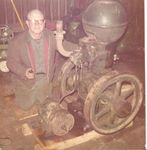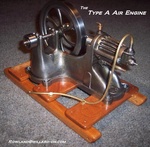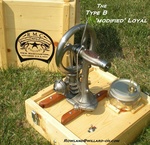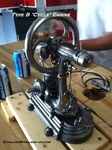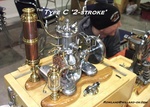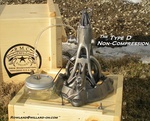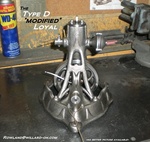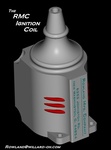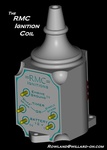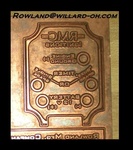What is RMC?
Rowland Manufacturing Company produces simple, "old-styled" model engine castings that can be easily machined into many different engines & layouts. The goal is to give people who are interested in model engines, but who might not have prior machining experience (or a fully equipped shop); a nice, simple & affordable engine they can build themselves.
There are many versions, styles or "types" of engines available. (For example, the type A engine, the type B engine, ect) Each type of engine has different machining steps & can be built a variety of ways. (Different engine cycles, different porting, valving & governor arrangements, ect.) Basically depending on the skill level of the builder, they can pick which engine they like best that can be made with the equipment they have.For the experienced builder, one of the more elaborate engines RMC will release as kits is the type B "Cycle" engine, shown below. The simpler engines that will be released are varieties of gas engines, air/steam engines & hot air engines, with some that can basically be machined with nothing more than files/grinder, a hacksaw, a small drill press & some common drill bits & taps.
Note: RMC machining plans are meant to use with the castings but the dimensions & information in them can also be used for people that like to build their own fabricated engines from stock or junk materials.
The Type A "Flame" Engine: (click here for video) 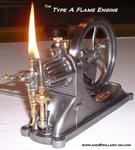
The Type A "Air" Engine: (click here for video)
The Type B "Modified Loyal" Engine: (click here for video)
The Type B "Cycle" Engine: (click here for video)
The Type C "2-stroke" Engine: (click here for video)
The Type D "Non-Compression" Engine: (click here for video)
The Type D "Modified Loyal" Engine: (click here for video)
What engines, kits & plans are currently available?
Right now, (Fall 2011), all that is available is:
*Plans & unmachined casting kits for the type B modified Loyal cycle engine:
*Unmachined sub-bases (with simple machining notes) for the type B engine:
*Machining plans & "glass head" stock for the type B engines:
*A limited number of finished type D "non-compression" engines will be available:
*Wooden display boxes for the above engines will also be available at request:
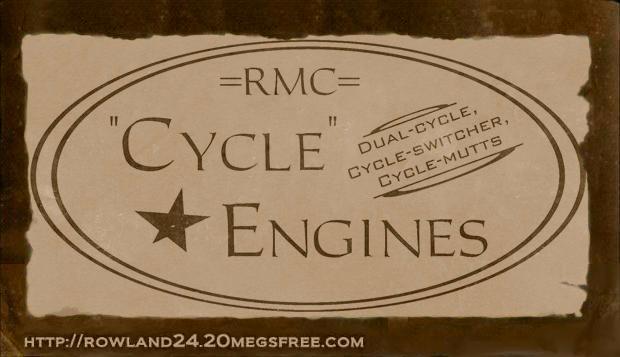
What are RMC "Cycle" engines?
First we should somewhat review an engine "stroke" & "cycle".
Strokes & Cycles:
Engine terminology can be a mess & for someone not familiar with engines, it can get confusing. When someone says "2-stroke" or "2-cycle", or "4-stroke" or "4-cycle", what does that mean?
In conventional engines (with a cylinder & piston), a stroke is just a movement of the piston. For example when the piston moves from "top dead center" (TDC) to "bottom dead center" (BDC), that is one stroke of the piston. When the piston reverses & moves from bottom dead center, then back to top dead center, that is another "stroke" of the piston.
Depending on the definition, a 2-stroke engine is just an engine that fires or completes its engine cycle in 2 strokes of the piston. A 4-stroke engine requires more movements of the piston to complete its cycle than a 2-stroke. A 4-stroke engine usually has an intake, compression, ignition/expansion & exhaust cycle spread over 4 strokes of the piston. After these "4 strokes" are completed, the engine "cycle" repeats.
The terms "2-cycle" or "4-cycle" just come from shortening the names of the "2-stroke cycle" or the "4-stroke cycle".
There are many variations of engine cycles, "2-stroke" or "4-stroke" are just generic names for each. For example, traditional non-compression engines run on a cycle usually referred to as the "Lenoir cycle" which is sometimes mislabeled as a 3-stroke engine. Actually these are 2-stroke engines that run on an engine cycle that has 3 "events or stages" (intake, ignition/expansion & exhaust) taking place in the cylinder that are spread out over 2-strokes of the piston. A variation of the 4-stroke cycle is the "Otto" or "Beau de Rochas Cycle" which is just one example among many, of a 4-stroke engine cycle.
So to answer the question, "What are RMC Cycle engines?" Depending on the engine, it could be a few things. Some are engines that can switch-over & run in completely different cycle modes, some are engines that can be run in combined stroke modes & some are engines that can run as both.
How can these engines switch cycles or run as a dual-stroke engine? On the simpler cycle engines this is usually done by changing one thing such as the ignition timing or adjusting the carburetion. On the more complex cycle engines this is done by changing the duration & sometimes the order of events happening in the cylinder.
One example of a RMC "cycle-switcher" engine is the type D, non-compression engine. These engines run as a hybrid/combination of a couple engine cycles & can switch the order of events happening in the cylinder just by moving the ignition timing lever. These engines can switch cycles from "intake, power, exhaust" to "intake, exhaust, power" & run as a haze or mixture of events in between. See video & web site below:
Another example of a RMC "cycle-switcher" (dual or multi-stroke) engine is the type B, "Cycle" engine. This engine can run as a 4-stroke engine, a 2-stroke engine or both at the same time. In 4-stroke mode it fires once every other crankshaft revolution with exhaust, intake, compression & power/expansion spread out over 4 strokes of the piston. In 2-stroke mode the engine fires each crankshaft revolution & runs as an open crankcase 2-stroke with compression. In its "dual or multi-stroke mode" the engine runs as both a 2-stroke & 4-stroke engine. Its main or primary explosion & power stroke takes place every other revolution of the crankshaft. On the "off" revolutions, the engine fires again & there is another but different explosion that takes place. Depending on the settings, this other explosion can have compression before it fires (ignites), or the engine can fire it as an uncompressed charge. This other explosion can also be utilized to add power to the engine or it can be fired off as a blank charge. The complete cycle repeats every other crankshaft revolution (every 4 strokes). This engine shows one of many ways to accomplish a dual-stroke engine.
Confusing?
With some small modifications the RMC type B "Cycle" engine can also run as a "dual-cycle" engine. To run as a dual-cycle, the engine runs on two different cycles that take place simultaneously in one engine. (For instance a 2-stroke cycle & a 4-stroke cycle, or two different 4-stroke cycles firing together or alternately, or two different/independent 2-stroke cycles).
To run as a dual, 2-stroke cycle & a 4-stroke cycle, the engine fires a consistent charge (fuel-air mixture) every crankshaft revolution in 2-stroke cycles of the piston. It also fires another consistent charge every other crankshaft revolution in 4-stroke cycles of the piston. It fires this 4-stroke cycle charge separately, but along with the same charge as in the first cycle & it can do this with one cylinder, using one side of the piston, with one combustion area. To do this it uses two flame fronts from different parts of the cylinder or the engine can have staggered ignition with one flame front traveling to ignite another portion of the cylinder. This is easy to do on large bore engines, but on small engines like the type B, things get tricky, (an elongated cylinder combustion area/extension was used to help it run). The type B Cycle engine can also run in "dual-cycle" mode as a "multi-stroke" engine (with explosions like described above). See video below.
It’s a versatile engine & can demonstrate a lot of things, & it’s a damn good runner.
Type B “Cycle” Engine Pictures
What will be released in the future?
As far as models, there will eventually be a new release of the type A engine along with different varieties of engines to build from it. There will also be updates of the past type A engines (improved versions of the RMC Flame engine & the RMC Air engine). At some point machining plans for the type C & SB engines will be finished & casting kits released. RMC has a couple versions of simple gearless cycle-switcher engines that plans will be available for. Plans for the RMC flame licker & a new type of hot air engine will also be released.
RMC is also finishing up a nice, affordable ($35), small-sized amplified ignition system for model (or full size) engines. It will come formed in a small, nice-looking and easy to mount case. This ignition coil can be used with Hall Effect sensors or miniature/scaled down versions of engine points (with no threat of burning them up). The same unit can be wired as a "single-spark, points open" system or a "continuous buzz coil, points closed" system. See pics below.
Some other projects/neat stuff;
-Years ago plans were made to build a few reproduction engines from an early American inventor. Since most of these engines were lost to time & no longer exist, RMC has been collecting any information available to make the reproductions as accurate as possible. Right now the plan is to build one-off, full-scale replicas of certain styles of these engines. (This is a long term, ever-going project).
-In the next few years RMC will release a full size V-twin motorcycle engine, not patterned off anything but just a clean-looking, wicked engine that is reliable & fun to run. Eventually a complete bike will be made to fit with the engine (& no doubt a trip to Sturgis made).
-Plans are made for a small (½" bore), switchable cycle (2-stroke/4-stroke) engine with compression prior to ignition, that’ll be built from the type E castings. The engine will have a traditional looking (crank-arm operated) slide valve for intake & flame ignition that is gasoline fueled. A neat feature on it will be a simple timing lever to adjust the flame ignition point while it runs. The engine should be a nice slow & smooth runner but in 2-stroke mode it should be able to rev to 3,000 rpm (with hopes of 4,500).
-Probably one of the neatest projects that RMC will soon show is the original "Cycle" engine. This is a large (3" bore) experimental engine that was made to test & experiment with using various cycles. Not counting generic cycles (6-stroke cycle, 8-stroke cycle, ect, which it can run in too), the engine can switch through at least 10 different "old-school/true" cycles & can run in many variations & combinations of them all (hybrid/dual-stroke/dual-cycle). It can also run in long periods with a fairly constant-temperature/isothermal power-stroke (with uncooled cylinder) of each cycle and it can switch through all this while it runs. The engines’ compression is variable from negative to self-ignition & other than stopping & starting it in reverse; it can be run in either direction without changing anything. It’s directly fuel-injected but also crudely carbureted & can self-adjust to any changes. Its looks are deceiving because it’s fairly simple for as much as it can do. The goal of this engine is to show what can be done & help promote ideas; it basically shows a lot of ways to spin the wheel.
RMC 2011
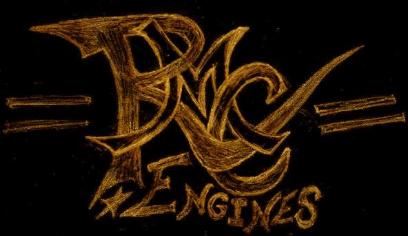
In Memory of Grandpa Willis "Red" Rowland 1919-1985
